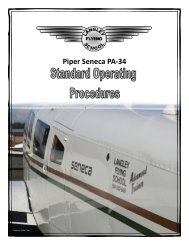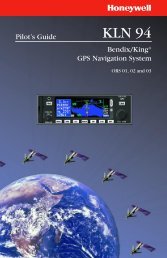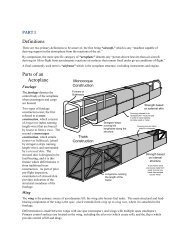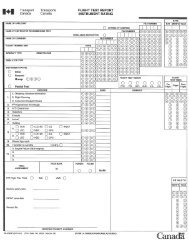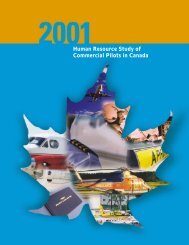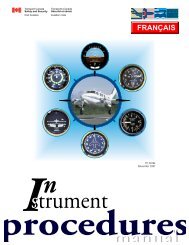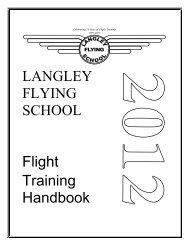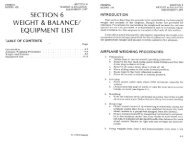Langley Flying School Private Pilot Groundschool Manual Sample ...
Langley Flying School Private Pilot Groundschool Manual Sample ...
Langley Flying School Private Pilot Groundschool Manual Sample ...
Create successful ePaper yourself
Turn your PDF publications into a flip-book with our unique Google optimized e-Paper software.
Dewpoint (°C)<strong>Private</strong> and Recreational <strong>Pilot</strong> <strong>Groundschool</strong> <strong>Manual</strong> Page 41<strong>Langley</strong> <strong>Flying</strong> <strong>School</strong>, Inc.2. set the mixture to full rich whenever climbing, also for cooling;3. set the mixture to best power or best economy whenever levelling at an altitude;4. always give priority to the aircraft or engine manufacturer’s requirements as described in the <strong>Pilot</strong>Operating Handbook, especially during takeoffs and landings.It should be noted that, owing to the extreme risk associated with fuel leaning in flight, <strong>Langley</strong> <strong>Flying</strong> <strong>School</strong> hasestablished very specific rules and procedures for leaning, which specify that the mixture must not be leaned below4,000’ ASL. For more information see <strong>Langley</strong> <strong>Flying</strong> <strong>School</strong>’s Flight Training Handbook.Fuel SystemsThere are two types of fuel systems: Gravity feed —high wing aircraft—and fuel-pump feed —low wing aircraft(mechanical & electric).Always carefully determine fuel quantity before flight; never trust fuel gauges; always dip tanks; and rememberthere must be 30 minutes of fuel in your tank when you land during the day, or 45 minutes when you land at night.In flight with multiple fuel tanks, manage fuel carefully; poor fuel management by the pilot related to multiple fueltanks has been the cause of many accidents.Always study an unfamiliar aircraft’s fuel system prior to takeoff—be sure you know what to do in the event of anemergency and you will not have time to consult the <strong>Pilot</strong> Operating Handbook when the emergency occurs.Always be especially sure of the vital actions to take in the event of an engine fire; the <strong>Pilot</strong> Operating Handbookprocedure for dealing with this emergency must be followed with complete accuracy so as to minimize the damageassociated with an engine fire.Special Considerations associated with Fuel 25Draining the fuel sumps before flight to examine fuel for contaminants, especially water (water is heavier than fueland therefore sinks to the bottom of fuel tank where the sumps are located).Checking fuel colour to determine fuel grade.Grounding aircraft during refuelling to prevent static discharge and possible fire; always supervise refuelling.Use of Jerry Cans should be discouraged owing to the inability to control static discharge.Passengers are not permitted in aircraft duringrefuelling.Carburettor IcingCarburettor icing is one of the most frequentcauses of unexpected engine failure duringflight.An encounter with carburettor icing is mostlikely when in moist air conditions and betweentemperatures of -5 and 30C.; a temperature of15C. presents the highest risk, but the RelativeHumidity must be at least 50%.The signs of carburettor icing are the signs of achoked carburettor—slow drop in RPM (fixedpitchpropellers), or slow drop in manifoldpressure (intake manifold on variable-pitchpropellers).-525 See also discussion P. 108 regarding the use of automobile fuel in aircraft.Graph showing that the greatest risk for carburettor icingoccurs at the convergence of dewpoint and temperaturebetween approximately -5°C and 30°C.© 2012 David L. ParrySerious icing withany power settingModerate icing with cruisepower or serious icing withdescent powerSerious icing withdescent powerLight icing0+5+10+20Temperature (°C)+30+30+20+10+50+5+40



